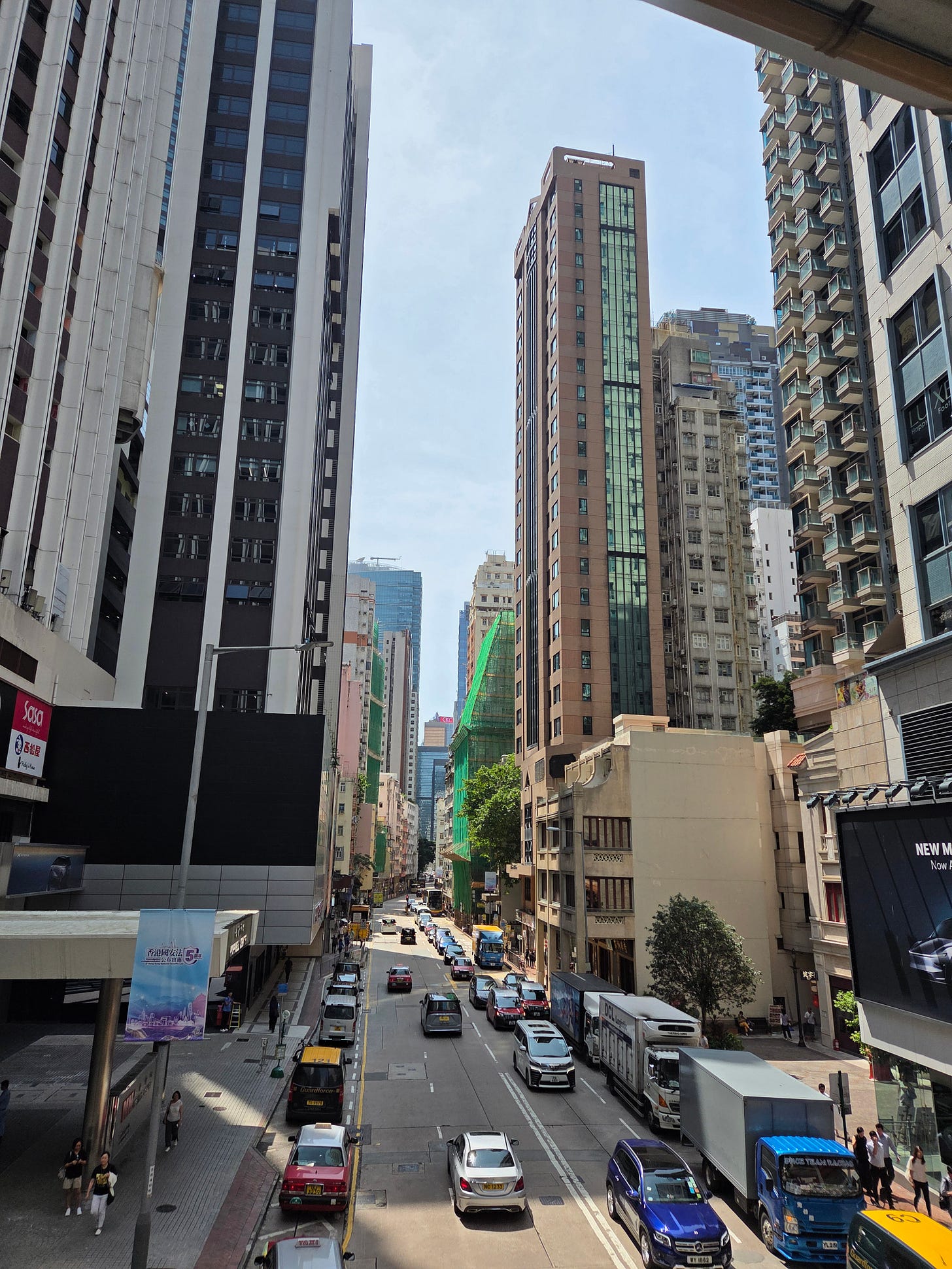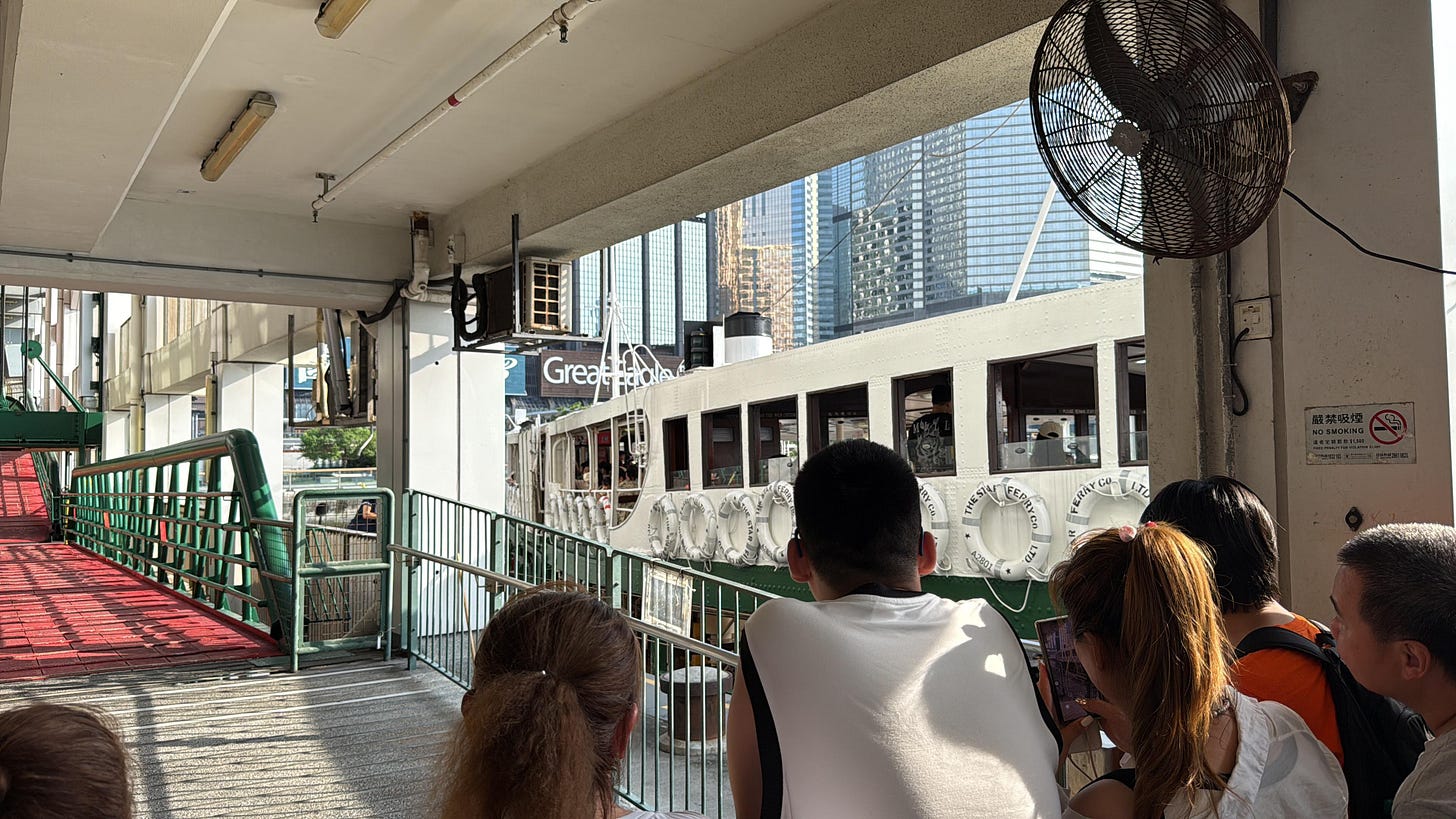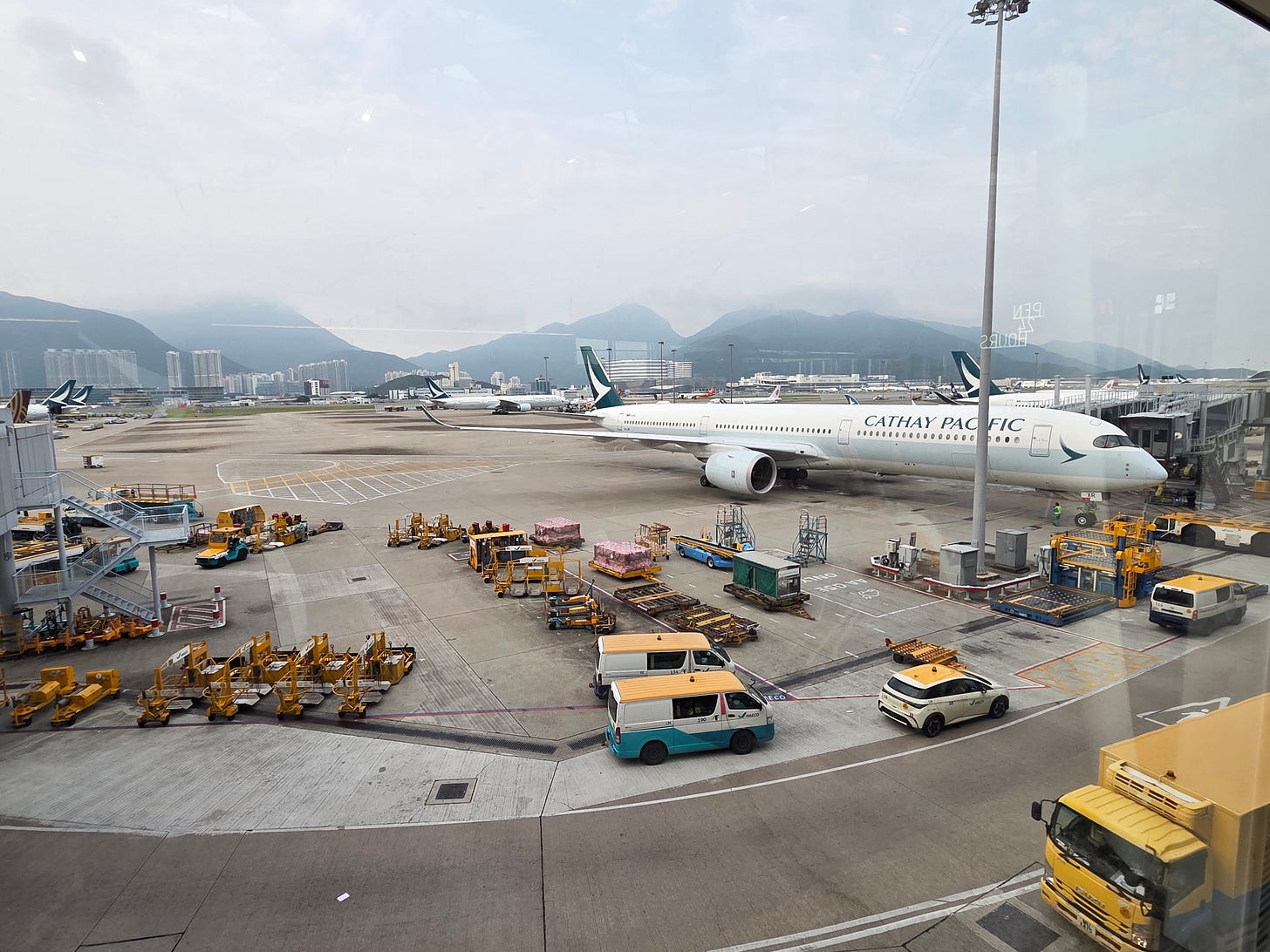Insights from our Hong Kong visit
Part one - Public Transit systems, Taxis, Private Cars, Electrical Grid
Priyans and I visited HongKong last month to attend Battery Tech Asia’s conference. It was our first visit abroad as ExpWithEVs and there’s a lot to unpack and learn from the city. In this article, we will cover :
Various public transport options and their electrification
Taxis, private cars and two wheelers.
Electrical grid
Before we dive deeper into it, here’s some housekeeping!
Housekeeping
Recap
2506 EVTrendsBI - A 10,000 ft overview of how charging infrastructure has grown in the country.
2506 EVInfraBI - A granular look at the charging infrastructure. Psst - this is now available state and CPO wise.
2506 EVHardwareBI - A closer look at the charger hardware market.
Roadtrip Invitation
We have observed that majority of EV industry leaders do not drive electric vehicles as a daily driver. The few who have a car, drive only within cities. Not many have driven across the country. We are inviting limited industry CXOs to join us on a multi day roadtrip. If this is something that interests you, please reach out.
Subscription
Today’s article is free and is proudly supported by our paying subscribers. Indians aren’t used to paying and we are glad to have early backers in our journey. You can sign up today to be a premium subscriber.
We always believe in independence and supporting creators. Here are some of the publications we subscribe to and you should too, if you like them!
Daily news - Newslaundry, LiveMint.
India Finance ELI5 - Boring Money by Shreedhar Manek
EV related - The EV Wire by Jaan (Global EV), Editor at InsightEV by Deepesh (Global e2W)
Technology - Ben Thompson’s Stratechery (Big Tech), CapTable (India startups and technology), Tech Buzz China (China focused).
Donation
Veditum India Foundation, a non profit where Priyans volunteers, is raising money this month. Help them meet their target of raising INR 8,00,000 and get a special gift from me. Send your donation receipt as proof. (Only Indian citizens can donate) Veditum works on India’s river ecosystems, freshwater resources and communities & biodiversity that are dependent on them, and the governance of these systems. Read more about their work.
Hong Kong
Hong Kong is a megapolis located next to mainland China. The nearby cities are Shenzhen and Macau. The megapolis is spread across four main islands.
It has atypical relationship with China, where Hong Kong is a Specially Administered Region for People’s Republic of China. Under the “one country, two systems” arrangement it keeps its own legal system, currency and immigration rules, even though foreign affairs and defence are handled by Beijing.
It is a hyper efficient, vertically stacked city, with a population density equivalent to Delhi NCR, where Cantonese (South China) culture, British Colonial remnants and Chinese governance intersect in this Asian megapolis.
Globally, it is the financial nerve center of the East with high presence of international banks and MNCs.
Public Transport
Like any other developed city, the public transport is very accessible and easiest way to get from Point A to Point B, for all classes of people.
A single Octopus card is sufficient to travel across the entire megapolis. We look at various options for Public Transport and compare their electrification levels to India.
MTR
This is the most important form of transport, commonly known as The Metro for Indians. The metro spans across the entire megapolis and is the preferred way of transport for most HongKongers. The entire metro network is electric, like metros in most cities around the world.
HSR Trains
Hong Kong has High Speed Railway Trains to various major cities in China, including Beijing, which over 2000 km away. All HSR routes are electrified, like most of the railway network in India.
Trams
Trams have served as a form of transport for over 100 years and has been electric, since it’s inception. Trams are one of the oldest methods of transport that is still active in Hong Kong.
Ferries
Since Hong Kong is spread over multiple islands, ferries help people transfer from one island to another. Majority of them are non electric. We went on one and that ran on fossil fuel.
News reports suggest that recently an electric ferry started operations. We believe that Hong Kong is slightly late to the game, as Indian cities like Kochi already have electric ferries being run by the Government on a daily basis.
Airports
The on ground fleet at Hong Kong airport was heavily electrified. Ground staff cars, feeder vehicles, minivans, feeder buses were all electric. It is likely a mandate by the aviation industry to decarbonize parts of their operations.
Buses
This was one of the most disappointing aspects of electrification. We traveled quite a bit in buses and all of them were run on fossil fuel. A few months ago, Priyans was in Singapore and observed the same thing.
A super rich megapolis running non electric buses is a sore to the eye. Indian cities like Delhi, Bengaluru and Mumbai are better off with continuous supply of electric buses.
Many buses, in both Singapore and Hong Kong, are double decker — ferrying many passengers. There must be fewer electric options in this configuration for the authorities to tender. Indian cities are constantly expanding and public transportation is never enough for the growing population, leading to regular procurement of buses.
Hong Kong and Singapore might procure new buses only after the end of life of existing buses. Let me know your thoughts in the comments!
Taxis
Taxis are yet another non electric dominant form of transportation. A lot of the existing taxis are like the age old Premier Padmini, a common sight in Indian cities. Like the olden era, these cars also operate on LPG (Liquified Petroleum Gas) unlike CNG (Compressed Natural Gas) in India.
There are some premium taxi apps offering both hybrid and electric cars. We were unable to try out BiggBoss Taxi, SynCab and HKTaxi which offer electric options among other types of taxis.
There’s no BluSmart equivalent or a pure play B2C EV fleet play in Hong Kong, to the best of our knowledge. Owning and operating a taxi in Hong Kong requires a government issued medallion which is scarce. This is the local government’s way of controlling access to the number of cars on road.
We will talk about something we saw at the Battery Show Asia in the electric taxi space in the next article.
We saw MPV (Multi Purpose Vehicle) segment cars dominating the privately held fleet taxis. Indian equivalents are eMax7, Carnival and Vellfire. We spotted MPVs from Japanese and increasingly Chinese automakers.
For instance, we saw quite a few SAIC’s M9 MPV under both brands - MG and MAXUS. M7 was also spotted. In India, JSW-MG has launched the M9 recently.
We saw quite a few Zeekr and Xpeng MPVs like 009 and X9. Denza, a JV between BYD and Daimler (Mercedes group) also had few MPVs on road in Hong Kong.
Cars
Owning a private car in Hong Kong is highly discouraged by the government and is seen as a luxury, given the widespread accessiblity of public transport. The government taxes anywhere between 40% to 115% for the first registration of the car, equivalent to India’s road tax. This tax is decided by the price of the car.
Despite being so close to China, the world’s largest automaker, we rarely saw any cheap / low priced cars in Hong Kong. The above disincentive prohibits users from spending money on cheap cars. They rather spend a bit more and get a branded car.
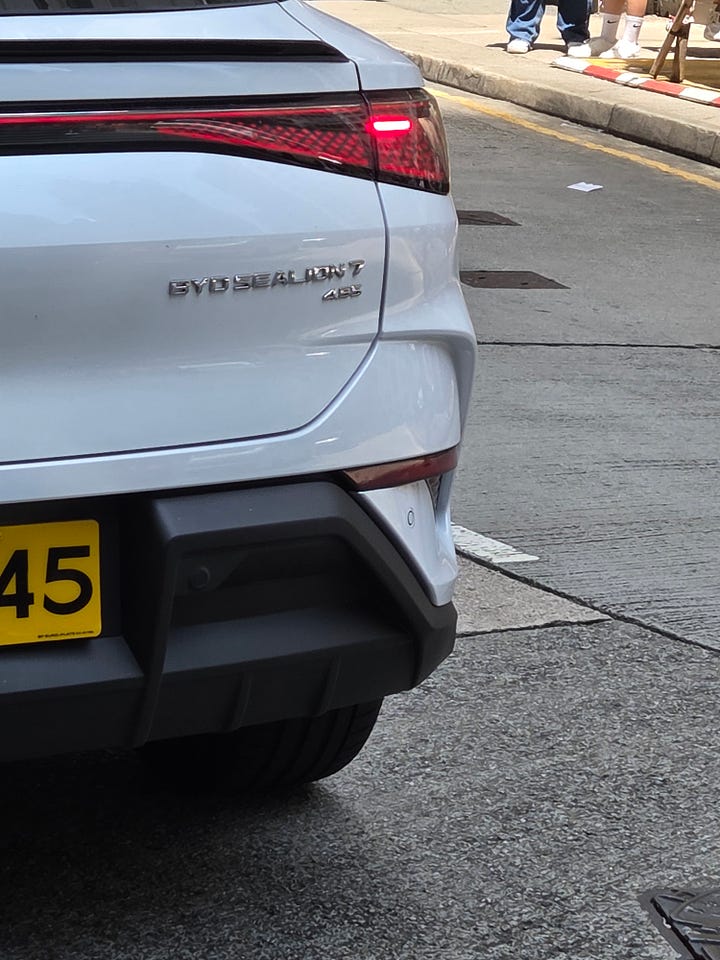
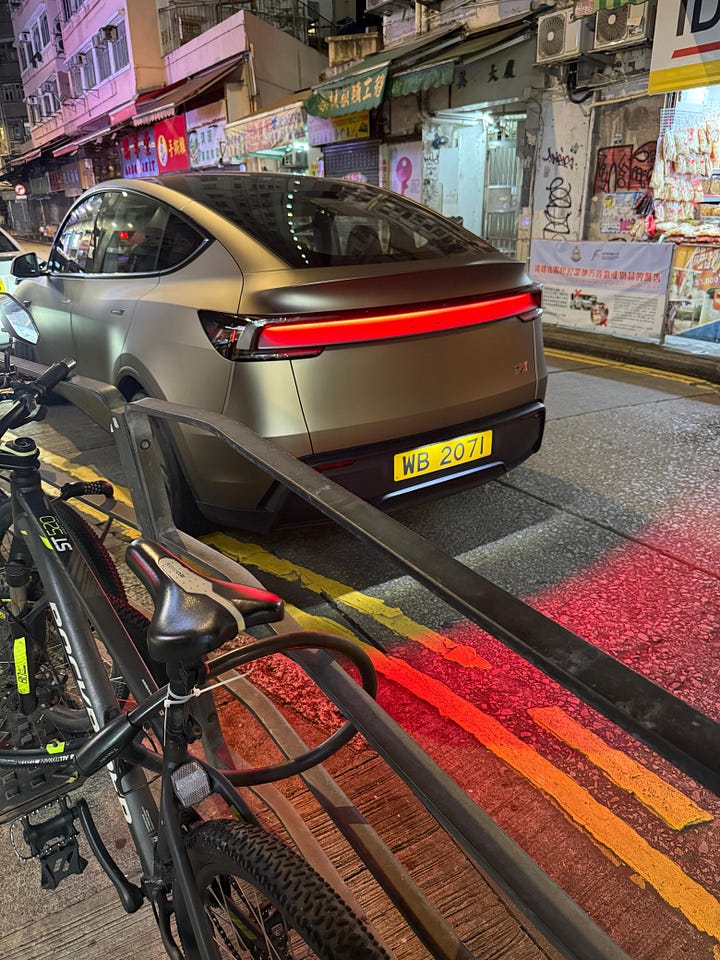
During our stay, we were able to spot only two SAIC’s ZS EV and one BYD Dolphin. For context, these are some of the affordable, value for money cars in the Chinese as well as other markets.
More than 50% of the cars spotted were all electrified. It included a lot of Teslas, BYD Sealion 7, XPengs and a few Nio cars. We rarely saw any small sized cars with the exception of one BMW Mini Cooper. The Western and Japanese OEMs refusing to embrace electric mobility are bound to lose market share in Hong Kong.
We were slightly disappointed to see fewer Chinese EVs as compared to Western EVs on Hong Kong roads.
Two Wheelers
We saw a lot of Japanese brands like Honda and Suzuki being used by delivery partners. We could not spot any electric two wheelers. Unlike the Indian and Chinese market, there weren’t any low speed electric two wheelers either.
This is a great segment for Indian companies like Ather Energy, Ultraviolette and River to look at Hong Kong as a market.
This situation is also eerily similar to that in Singapore, where there is little to none electrification in the two wheeler segment.
The only sustainable option in two wheelers are regular and electric cycles, which are prominent in both Hong Kong and Singapore.
Charging Infrastructure
Chargers on highways in India are located right on the highway or next to wayside amenities and shops. These chargers are usually identifiable from a distance.
Hong Kong is a vertical city with practically no ‘inter city’ highways. Naturally, majority of the charging stations are located in the city boundaries, within malls, buildings, or other amenities.
As an outsider, it took us quite a bit of time to locate the chargers in various parking lots. Getting used to the vertical aspect of the city is challenging.
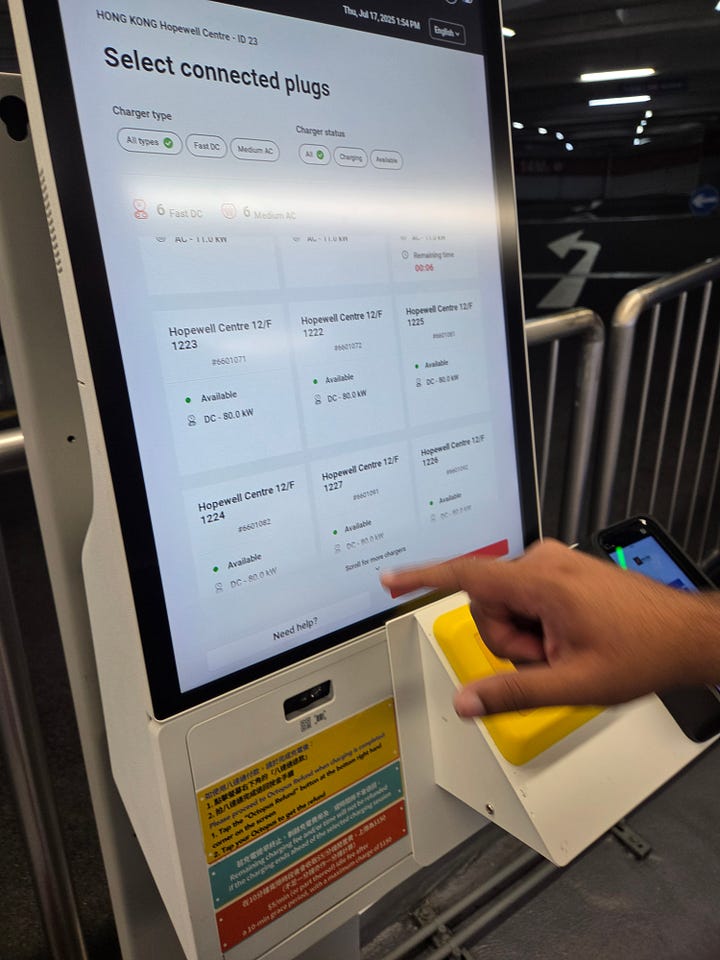
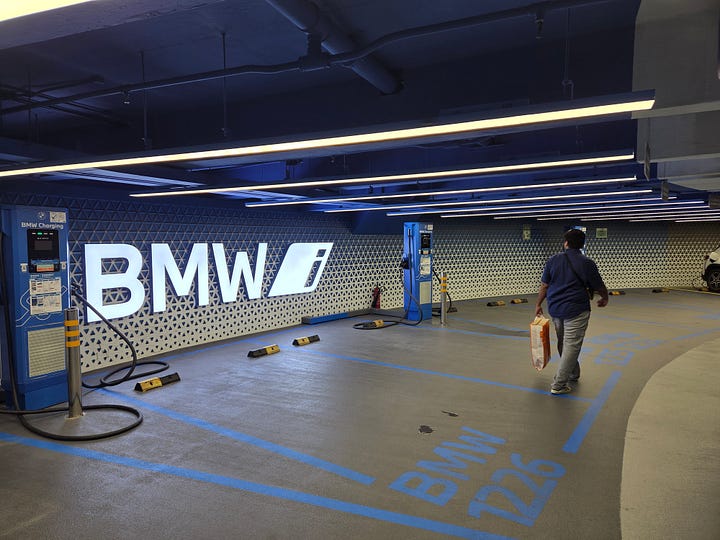
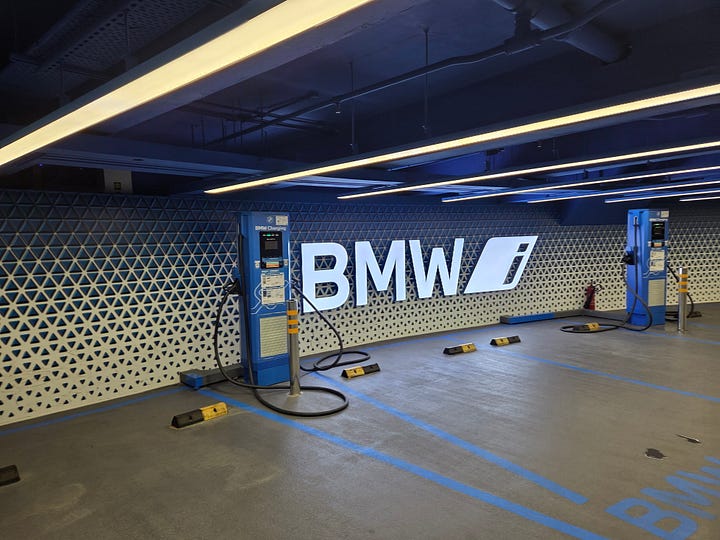
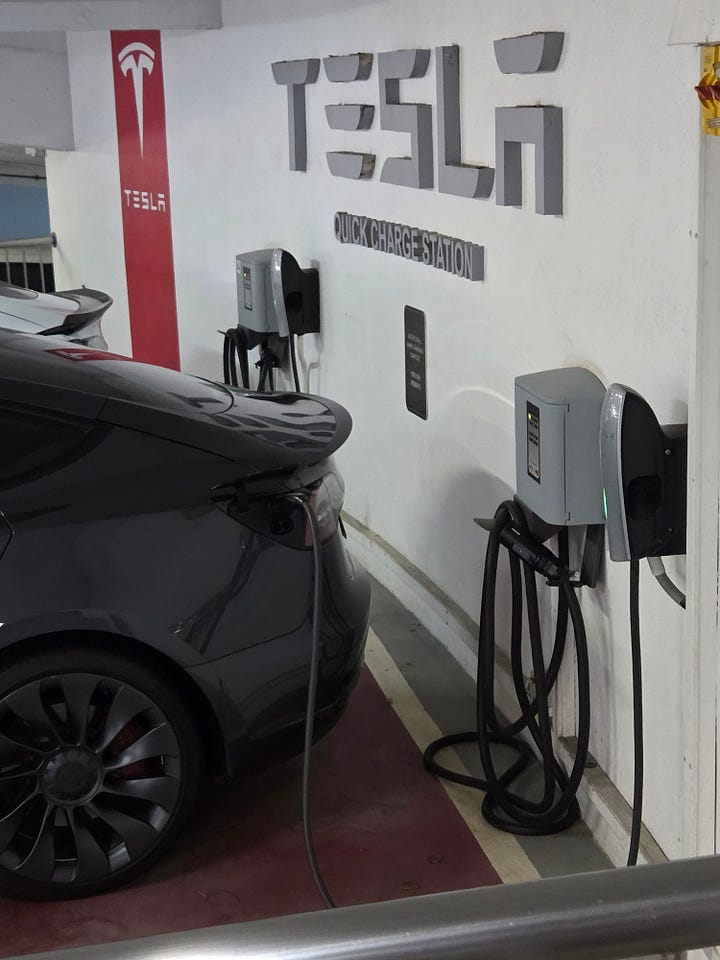
Electrical Grid
International Energy Agency states that Hong Kong’s electrical grid is not clean. The largest source of energy production is via natural gas, accounting for 63%. Almost 35% electricity generation is reliant on coal.
Thus, majority of the electricity consumed in Hong Kong is generated via fossil fuels. Hong Kong also imports energy from the Chinese mainland. Due to land scarcity, it is difficult to do large scale renewable energy installations like solar plants. Offshore wind energy is another way to produce electricity through renewable sources.
Bonus - Walking
Walking is another energy efficient public transport, easily possible in Hong Kong. The city is clean, has a pedestrian first approach and is lovely to walk around. Despite using a lot of public transport, Priyans and I still ended up walking close to 10 km a day without any hassle. Try walking in a major metro city in India and see how engaged you have to be, unlike the experience in Hong Kong.
In the next week’s article, we will talk about how EV infrastructure is developing in the ASEAN markets, what is the latest update on the battery tech from Hong Kong and address some of the questions by our premium subscribers.
Author Credits : Garvit Singh
This piece is proprietary and a property of ExpWithEVs. You may not republish, copy, edit, repost or reshare this piece without prior written confirmation from ExpWithEVs via email : priyans@expwithevs.in


